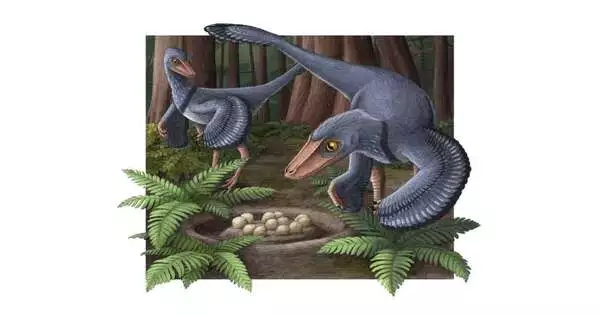Troodon, a dinosaur closely related to contemporary birds, was found to be a warm-blooded (endothermic) creature with a reproductive system resembling that of contemporary reptiles by an international research team headed by Goethe University Frankfurt, Germany.
The temperature at which the carbonate shell of the egg formed could be precisely determined thanks to the scientists’ use of a novel technique. The study’s findings also revealed that Troodon produced 4 to 6 eggs per clutch. The researchers draw the conclusion that several Troodon females laid their eggs in collective nests because they have discovered nests with up to 24 Troodon eggs.
Evolution transformed a specific group of dinosaurs, the theropods, into the birds we observe flying around the planet today over millions of years and through a protracted series of small changes. Actually, the Cretaceous period’s catastrophic extinction 66 million years ago left only birds as the last living descendants of dinosaurs.
“The Troodon eggshell isotopic composition shows that these extinct animals had a body temperature of 42°C and that they were able to decrease it to roughly 30°C, like current birds,”
Mattia Tagliavento, leading author of the study,
This theropod was Troodon. Approximately 75 million years ago, a carnivorous dinosaur about two meters long lived in the vast semi-arid regions of North America. Troodon had some bird-like characteristics, such as hollow and light bones, like some of its dinosaur relatives. Troodon had fully developed feathery wings and two legs for walking, but due to its size, it was unable to fly. Instead, it most likely took to running quickly and capturing its prey with its powerful claws.
The asymmetrical eggs of modern birds resemble those laid by troodon females more than the round eggs of reptiles, which are the oldest dinosaur relatives. These colored eggs were discovered partially buried in the ground, presumably allowing Troodon to sit and tend to them.
The calcium carbonate of some well-preserved Troodon eggshells has recently been studied by an international team of researchers led by Mattia Tagliavento and Jens Fiebig from Goethe University Frankfurt, Germany. Dual clumped isotope thermometry is a technique that the researchers used that was created by Fiebig’s team in 2019.”.
They could measure the degree to which heavier isotopes of oxygen and carbon clump together in carbonate minerals by employing this technique. It was possible for researchers to establish the temperature at which the carbonates crystallized because of the prevalence of isotopic clumping, which is temperature-dependent.
The research team was able to ascertain from studying Troodon eggshells that the eggshells were made between 42 and 30 degrees Celsius. The study’s lead author, Mattia Tagliavento, says that the isotopic makeup of Troodon eggshells “provides evidence that these extinct animals had a body temperature of 42°C and that they were able to reduce it to about 30°C, like modern birds.”.
To determine whether Troodon was more closely related to birds or reptiles, the researchers compared the isotopic compositions of the eggshells of modern birds (chicken, sparrow, wren, emu, kiwi, cassowary, and ostrich) and reptiles (crocodile, alligator, and various species of turtle). They discovered two distinct isotopic patterns: reptile eggshells have isotopic compositions that correspond to the temperature of the surrounding environment. This is consistent with these creatures’ cold-bloodedness and their slow egg-formation processes.
However, birds leave a recognizable so-called non-thermal signature in the isotopic composition, indicating that eggshell formation occurs very quickly. According to Tagliavento, “We believe that the very high production rate is due to the fact that birds only have one ovary, unlike reptiles. Birds must produce eggs more quickly because they can only produce one egg at a time.
The researchers were unable to find the isotopic composition that is typical for birds when comparing these findings to Troodon eggshells. “This demonstrates that Troodon formed its eggs in a way more comparable to modern reptiles, and it implies that its reproductive system was still constituted of two ovaries,” says Tagliavento, who is persuaded by the evidence. “.
Troodon only produced 4 to 6 eggs during each reproductive phase, the researchers concluded after combining their findings with previously known data on body and eggshell weight. Tagliavento says, “This observation is particularly interesting because Troodon nests are typically large, containing up to 24 eggs.” We believe that this is strong evidence that female Troodons laid their eggs in communal nests, a behavior that we also see in contemporary ostriches.”.
The dual clumped isotope method was originally created by Jens Fiebig and his team in order to precisely reconstruct the Earth’s surface temperatures during previous geological eras. This study demonstrates that our method can be used for more than just temperature reconstruction, and it offers the chance to look at how carbonate biomineralization has changed over the course of Earth’s history.
The research is printed in the Proceedings of the National Academy of Sciences journal.
More information: Tagliavento, Mattia, Evidence for heterothermic endothermy and reptile-like eggshell mineralization in Troodon, a non-avian maniraptoran theropod, Proceedings of the National Academy of Sciences (2023). DOI: 10.1073/pnas.2213987120





